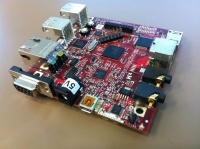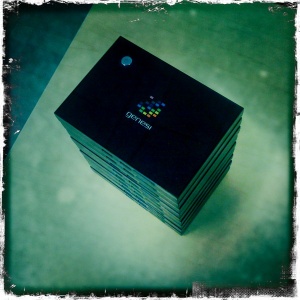Fedora 17 for ARM

BeagleBoard-xM
A modified version of the popular BeagleBoard, the BeagleBoard-xM is a very small, low powered ARM device designed with open source software development in mind. The Beagleboard-xM is produced by Texas Instruments and Digikey and offers a showcase for TI's OMAP3730 system-on-a-chip(SoC).
Technical Specifications
- TI DM3730 Processor - 1 GHz ARM Cortex-A8 core
- 512 MB LPDDR RAM
- Imagination Technologies PowerVR SGX 2D/3D graphics processor
- DVI-D (HDMI connector chosen for size - maximum resolution is 1400x1050)
- 10/100Mbit/s Ethernet
For more information on the BeagleBoard-xM visit their website.
Running Fedora on a BeagleBoard-xM
This page will give you detailed instructions for running Fedora 17 GA on your BeagleBoard-xM. There are two images to choose from on the BeagleBoard-xM - a HFP(Hard float) or SFP(Soft Float) image, both will boot to a serial console.
Download the image
The first step is to download the Fedora 17 image. The prebuilt images include kernels and can be written directly to an SD Card and booted without any additional steps or configuration. The images require a minimum of 2GB.
Writing the Image
Linux Users
You can write the image to an SD card of your choosing but it does have to meet the minimum size requirements noted above (2GB for the serial image, 4GB for the XFCE Desktop). Connect the SD card to your computer and make note of the drive. To write the image to your SD card run the following command, changing the drive to the location of your SD card.
For the HFP Image:
xzcat Fedora-17-armhfp-beagle-mmcblk0.img.xz > /dev/<location-of-your-SD-card>
For the SFP Image:
xzcat Fedora-17-arm-beagle-mmcblk0.img.xz > /dev/<location-of-your-SD-card>
Once completed run the below command to ensure the entire image is written to the card:
sync
Windows Users
- You will need to download Win32 Image Writer as well as a tool to extract the image such as 7-Zip.
- Once downloaded and installed right click on the disk image and select "7-Zip->Extract files here"
- Launch Win 32 Disk Imager and select the extracted disk image and the SD card you would like to write the files to. Click "Write". Be very careful during this step - all data on the selected drive will be lost!
Mac Users
- Please note that the Default Archive Utility.app will not extract the .xz file. A third party app will have to be used to decompress it. There are multiple options for that
- There is a Free App available in the App Store called Unarchiver.
- If mac homebrew or macport is already installed, then the xz utility can be downloaded and installed using one of those.
- The xz utils .pkg for mac can be downloaded and installed directly from xz utils
- Once the xz utility is installed, open a terminal and make a note of the current drives.
ls /dev/disk?
- Connect the SD card to the mac and make a note of the drive.
- Open Disk Utility and make sure that the card and all the partitions in the card (if any) is unmounted
- In the terminal change to the directory where the .xz file is located
- If xz was installed from the .pkg or macport or homebrew then run the following command
xzcat Fedora-17-armhfp-beagle-mmcblk0.img.xz > /dev/<location-of-the-SD-card>
- If the Unarchiver app from App Store was used then just click and decompress the .xz file and then run the following (may require sudo)
dd if=Fedora-17-armhfp-beagle-mmcblk0.img of=/dev/<location-of-the-SD-card>
- Click and eject the SD card
Using Fedora on the BeagleBoard-xM
Connect the newly created media to your BeagleBoard-xM and power on. No further steps are required and your system should boot to a text based log in prompt. The default root password is "fedoraarm". This should be changed immediately.
Known Issues
- BeagleBoard-xM generates a kernel warning on reboot and requires use of the reset button to actually reboot.
- Yum requires the system time be correct for HTTPS to function. If yum updates are not working check your clock.
- The tar.xz rootfs archives do not preserve SELinux information or file capabilities. If you use these to create your own filesystem image it is recommended that you switch SELinux to use warnings instead of enforcing for first boot, then relabel and reinstall packages that rely upon filesystem capabilities such as glibc-common and ping.
- Images are designed to be written to 2GB (console) or 4GB (xfce) SD cards. On first boot the partition will be resized to the maximum allowable amount. On the second boot the filesystem will be resized to fill the expanded partition. This works for SD cards, SATA Disks, and SSD drives.
- Known release issues
Additional Support
There are Fedora ARM users all around the globe - if you need assistance, would like to provide feedback or contribute to Fedora ARM please visit us on the IRC - we can be found in #fedora-arm[?] on Freenode. You can also contact us on the mailing list - arm

EFIKA MX Smarttop
The EFIKA MX Smarttop is a network computer based around the EFIKA MX micro-motherboard and requires no more than 5W to fully operate. At this time there is no support for a display and the Smarttop boots to a serial console.
Technical Specifications
- Freescale i.MX515 (ARM Cortex-A8 800MHz)
- 512MB RAM
- WXGA(1280×768) display support (HDMI)
- 10/100Mbit/s Ethernet
- 802.11 b/g/n WiFi
For more information on the EFIKA MX Smarttop visit their website.
Running Fedora on a EFIKA MX Smarttop
This page will give you detailed instructions for running Fedora 17 GA on your EFIKA MX Smarttop. The image is suitable for writing to a minimum of 2GB SD card and boots to a serial console.
Download the image
The first step is to download the Fedora 17 image. The prebuilt images include kernels and can be written directly to an SD Card and booted without any additional steps or configuration. The image requires a minimum of 2GB and boots to a serial console.
Writing the Image
Linux Users
You can write the image to an SD Card of your choosing but it does have to meet the minimum size requirement of 2GB. Connect the SD Card to your computer and make note of the drive. To write the image to your media run the following command, changing the drive to the location of your SD Card.
For the SD Image:
Fedora-17-armhfp-mx51-mmcblk0.img.xz> /dev/<location-of-your-SD-Card>
Once completed run the below command to ensure the entire image is written to the device:
sync
Windows Users
- You will need to download Win32 Image Writer as well as a tool to extract the image such as 7-Zip.
- Once downloaded and installed right click on the disk image and select "7-Zip->Extract files here"
- Launch Win 32 Disk Imager and select the extracted disk image and the device you would like to write the files to. Click "Write". Be very careful during this step - all data on the selected drive will be lost!
Mac Users
- Please note that the Default Archive Utility.app will not extract the .xz file. A third party app will have to be used to decompress it. There are multiple options for that
- There is a Free App available in the App Store called Unarchiver.
- If mac homebrew or macport is already installed, then the xz utility can be downloaded and installed using one of those.
- The xz utils .pkg for mac can be downloaded and installed directly from xz utils
- Once the xz utility is installed, open a terminal and make a note of the current drives.
ls /dev/disk?
- Connect the SD card to the mac and make a note of the drive.
- Open Disk Utility and make sure that the card and all the partitions in the card (if any) is unmounted
- In the terminal change to the directory where the .xz file is located
- If xz was installed from the .pkg or macport or homebrew then run the following command
xzcat Fedora-17-armhfp-mx51-mmcblk0.img.xz > /dev/<location-of-the-SD-card>
- If the Unarchiver app from App Store was used then just click and decompress the .xz file and then run the following (may require sudo)
dd if=Fedora-17-armhfp-mx51-mmcblk0.img.xz of=/dev/<location-of-the-SD-card>
- Click and eject the SD card
Using Fedora on the EFIKA MX Smarttop
Connect the newly created media to your EFIKA MX Smarttop and power on. No further steps are required and your system should boot to a serial console log in prompt. If you do not have a serial cable to connect your Smarttop, you can watch your DHCP server for the newly connected device. After a few minutes you should be able to see the host "fedora-arm'. Use SSH to connect to the root account.
ssh root@fedora-arm (or IP)
The default root password is "fedoraarm". This should be changed immediately.
Known Issues
- Yum requires the system time be correct for HTTPS to function. If yum updates are not working check your clock.
- Genesi Efika MX SmartTop generates a kernel warning on reboot and requires use of the reset button to actually reboot.
- The tar.xz rootfs archives do not preserve SELinux information or file capabilities. If you use these to create your own filesystem image it is recommended that you switch SELinux to use warnings instead of enforcing for first boot, then relabel and reinstall packages that rely upon filesystem capabilities such as glibc-common and ping.
- Images are designed to be written to a minimum of 2GB SD cards. On first boot the partition will be resized to the maximum allowable amount. On the second boot the filesystem will be resized to fill the expanded partition. This works for SD cards, SATA Disks, and SSD drives.
- Known release issues
Additional Support
There are Fedora ARM users all around the globe - if you need assistance, would like to provide feedback or contribute to Fedora ARM please visit us on the IRC - we can be found in #fedora-arm[?] on Freenode. You can also contact us on the mailing list - arm
